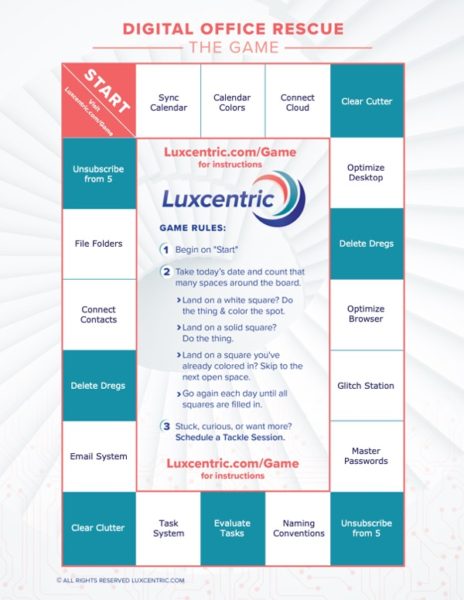Review Your Calendar
Reviewing your calendar is not strictly a technology activity. However, knowing what you need to accomplish on a regular basis and for the future will also tell you what technology you need and how you should organize it. It will do you no good to set a goal to improve and maintain an organized digital office if you do not have the time and space to actually implement the activities to make it possible.
The BLOG POST: The Rhythm of a Good Task List digs into all the little things you need to accomplish. The exercise will help you make sure you have the time and bandwidth to actually accomplish the tasks you need to accomplish. Ideally, you will have a regular (weekly) scheduled time set aside to do your planning. Reviewing your calendar is an integral part of that planning.
As part of your planning day goals, you should be able to look at your calendar and know where you need to be for the next week or two, when you need to be there, and what you need to have prepared before you arrive.
- Is everything on your calendar?
- Do you need to prepare for any of your appointments?
- Have you blocked out time for transitions?
- Do you have enough time to focus on the work you need to do?
- And most important, do you have personal and family time protected so you don’t get overloaded with work?
STEP 1: Gather and confirm that your appointments are on your calendar for the next 2 weeks.
As you go about your day you need to have a consistent place where you put your appointments, so you don’t over book yourself. The best option is a digital calendar on your phone. A digital calendar on your phone is with you at all times and it is easy to check and enter appointments.
Not everyone resonates with a digital calendar. That is ok. If you are using a paper calendar or a note pad to keep track of appointments, it is even more important that you have a consistent habit of making sure it is up to date.
If you are using an automatic schedular for your client appointments, you need to be extra careful and diligent.
The BLOG POST: How to Prepare your Calendar for an Automatic Scheduler will walk you through the things you need to know if you want to get an automatic scheduler set up in your system.
A final word of warning: do not rely on reminders from other people’s systems.
STEP 2: Set aside time in your calendar to prepare for any appointments you have.
What information and resources do you need to complete this appointment successfully?
Do you have or need the address to a location? Proactively enter it into your event entry’s location field so you have it available when you need to head on out.
What about the video conference link? or other information you will need at the time of the appointment. When you receive the email with this information it is a good idea to make sure the information from the email is in the event description, so you don’t need to go hunting through your email when the time comes. This also allows you to file that email away and get it out of your inbox.
Do you need other information? Will it take time outside of the appointment to gather that information?
Having an appointment on your calendar is a great reminder of work that needs to be done, but do not assume that you automatically will remember to do the prep work for the event. Block out specific time (before the event) on your calendar to do the work. Or at least add it to your task list with an appropriate due date.
STEP 3: Block out time for transitions
The most common reason people are late to appointments is because they do not consider how much time it actually takes to transition from one task to another.
When you prepare to leave for an appointment do you leave your house at the time the appointment starts? Of course not, you calculate drive-time.
That is an easy one, but how about look-for-your-keys time or put-on-your-shoes time? Tell-your-people-goodbye time. These little things add up.
It is also unreasonable to think that you can go from appointment to appointment with no buffer for taking notes or shifting your brain. Even for online appointments give yourself space between appointments. It is much easier to do appointment wrap up right after an appointment than at the end of the day or the week.
Be sure to add some buffer time between your appointments.
STEP 4: Block out time to focus on the work you need to do
Giving yourself space to do your work is freedom.
You may love your job, or you may hate it. Either way you will not be able to do good work if you do not have the time space. Giving yourself space to do your work and do it well will help you gain, regain, and maintain the joy. Allow yourself to slow down. Rushing through things is not efficient and saving time is not the only goal.
If you do not enjoy the work you used to love, take a look at your calendar. Are you being forced to rush? Are you lacking the time necessary to up level your skill? All things take time and need space for implementation.
Step 5: Protect your personal and family time
The purpose of our lives is to live and connect with our people. Some of those people may be part of your work, but you also want time that is not work. Alone time, family time, time with friends. White space time. Block it out on your calendar and shift it as you need.
Extra bonus on this: When someone asks for a time that is designated personal or family and you do not want to give it up you can truthfully and politely say. “Could we schedule for another time? I have an appointment.”
Your Calendar and your productivity
Your task list and your calendar are intrinsically linked. Everything you wish to do in life will require time to do it. To make sure you have the space to protected for the things you actually wish to do.
Stephen Covey’s 7 Habits of Highly Effective People is a classic for leading people toward identifying what they actually want to achieve.
Knowing what you want to achieve is the top-level activity.
Determining what needs to be done to achieve that thing is the glandular level activity.
David Allen’s Getting Things Done is an excellent book on productivity it shares very specific step by step instructions for collecting all the things you need to do to achieve the things you wish to achieve.
Having an up to date and carefully monitored calendar will allow you to be the one in control of your time and bandwidth. Be intentional.
You will find that once you are regularly in the habit of evaluating your calendar you will know what you can or cannot add to your life. Saying no to things you don’t want or need in your life will be much easier and you will have access to actual tangible reasons for the choices you make with your time and energy.
Resources Associated with This Game Space:
BLOG POST: The Rhythm of a Good Task List
BLOG POST: How to Prepare your Calendar for an Automatic Scheduler
BOOK RECOMENDATION: David Allen’s Getting Things Done
BOOK RECOMENDATION: Stephen Covey’s 7 Habits of Highly Effective People
Good Luck,
Nicole
The Next Game Space
When you are ready for the next Game Space check-out: Delete the Dregs
Your mission, should you choose to accept it,
is to Rescue your Digital Office.

In this regular* email dispatch, you will receive the guidance you need to Rescue your Digital Office!
*about every other week



